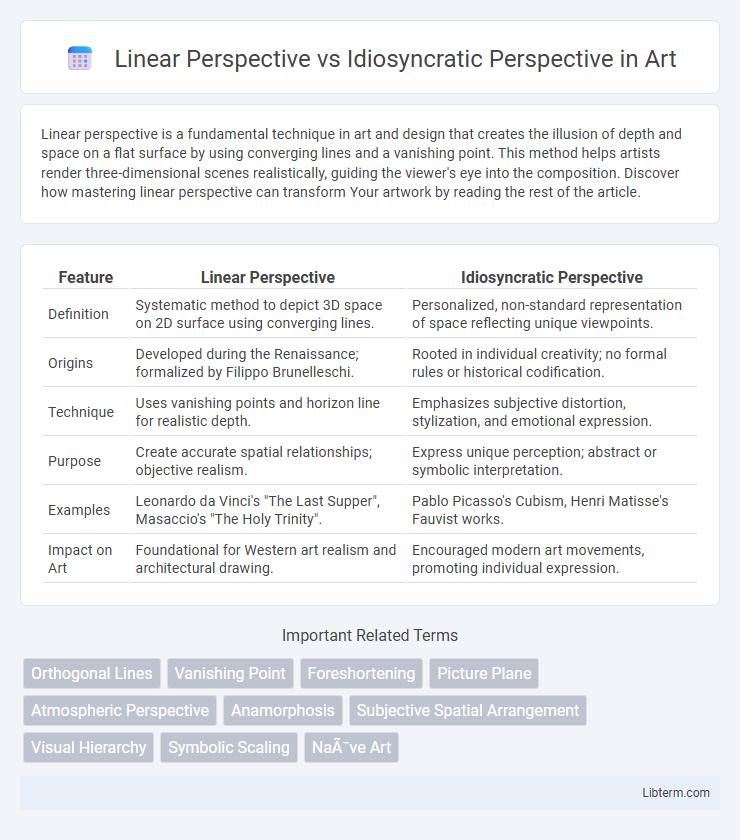Linear perspective is a fundamental technique in art and design that creates the illusion of depth and space on a flat surface by using converging lines and a vanishing point. This method helps artists render three-dimensional scenes realistically, guiding the viewer's eye into the composition. Discover how mastering linear perspective can transform Your artwork by reading the rest of the article.
Table of Comparison
| Feature | Linear Perspective | Idiosyncratic Perspective |
|---|---|---|
| Definition | Systematic method to depict 3D space on 2D surface using converging lines. | Personalized, non-standard representation of space reflecting unique viewpoints. |
| Origins | Developed during the Renaissance; formalized by Filippo Brunelleschi. | Rooted in individual creativity; no formal rules or historical codification. |
| Technique | Uses vanishing points and horizon line for realistic depth. | Emphasizes subjective distortion, stylization, and emotional expression. |
| Purpose | Create accurate spatial relationships; objective realism. | Express unique perception; abstract or symbolic interpretation. |
| Examples | Leonardo da Vinci's "The Last Supper", Masaccio's "The Holy Trinity". | Pablo Picasso's Cubism, Henri Matisse's Fauvist works. |
| Impact on Art | Foundational for Western art realism and architectural drawing. | Encouraged modern art movements, promoting individual expression. |
Introduction to Artistic Perspectives
Linear perspective in art uses mathematical principles to create the illusion of depth by converging parallel lines at a vanishing point, establishing spatial accuracy and realism. Idiosyncratic perspective defies these rules, reflecting an artist's unique vision or emotional expression through distorted or unconventional spatial representation. Understanding both perspectives provides insight into the evolution of artistic techniques and the balance between structured realism and personal interpretation.
Defining Linear Perspective
Linear perspective is a mathematical system used in art to create the illusion of depth and space on a flat surface by converging parallel lines toward one or more vanishing points on the horizon. This technique relies on geometric principles to accurately represent spatial relationships and scale, making scenes appear realistic and proportionate. In contrast, idiosyncratic perspective emphasizes subjective or unconventional viewpoints, often distorting spatial accuracy for expressive or symbolic effects.
Understanding Idiosyncratic Perspective
Idiosyncratic perspective emphasizes individual interpretation shaped by personal experiences, beliefs, and cognitive biases, contrasting with the objective, rule-based approach of linear perspective. Understanding idiosyncratic perspective requires recognizing how subjective realities influence perception and decision-making in complex situations. This approach is crucial in fields like psychology, art, and user experience design, where personal context drives unique responses and interpretations.
Historical Origins and Evolution
Linear perspective emerged during the Italian Renaissance in the 15th century, pioneered by Filippo Brunelleschi and later formalized by Leon Battista Alberti to create mathematically precise spatial depth on flat surfaces. Idiosyncratic perspective, contrastingly, stems from non-Western art traditions and modernist movements, prioritizing subjective and often distorted viewpoints to convey personal or cultural experiences. Over time, linear perspective shaped Western artistic conventions globally, while idiosyncratic perspectives expanded expressive possibilities beyond strict geometric rules.
Techniques and Application in Art
Linear perspective employs mathematical principles and vanishing points to create accurate depth and spatial relationships in artworks, commonly used in Renaissance art to achieve realistic three-dimensional scenes. Idiosyncratic perspective, by contrast, embraces subjective viewpoints and distorted proportions to convey emotional or symbolic meaning, often found in Expressionism and Surrealism. Techniques in idiosyncratic perspective include exaggerated angles and unconventional scales, allowing artists to emphasize personal interpretation over optical accuracy.
Visual Impact: Realism vs Expression
Linear perspective creates a visual impact centered on realism by using geometric principles to depict space and depth accurately, enhancing the viewer's sense of three-dimensionality. Idiosyncratic perspective prioritizes expression by distorting or altering spatial relationships to convey subjective emotions and unique viewpoints. This contrast highlights how linear perspective builds believable scenes, while idiosyncratic perspective emphasizes personal interpretation and artistic freedom.
Key Artists and Influential Works
Linear perspective, pioneered by Filippo Brunelleschi during the Italian Renaissance, is prominently exemplified in works like Leonardo da Vinci's "The Last Supper" and Masaccio's "The Holy Trinity," emphasizing geometric precision and vanishing points to create depth. Idiosyncratic perspective, often associated with artists such as Pablo Picasso and Salvador Dali, breaks conventional rules to convey subjective experience and psychological depth, as seen in Picasso's "Les Demoiselles d'Avignon" and Dali's "The Persistence of Memory." These contrasting approaches reflect the evolution from Renaissance naturalism to modernist exploration of perception and space.
Comparative Analysis: Strengths and Limitations
Linear perspective offers a structured approach to depicting three-dimensional space with mathematical precision, enhancing realism by maintaining consistent vanishing points and proportionate scale. Idiosyncratic perspective embraces subjective representation, allowing for creative expression and emotional emphasis but often sacrificing spatial accuracy and coherence. While linear perspective excels in technical accuracy and standardized visualization, idiosyncratic perspective provides flexibility and personal interpretation, highlighting the tension between objective realism and individual artistic vision.
Influence on Modern and Contemporary Art
Linear perspective, rooted in Renaissance principles, established a standardized method for representing three-dimensional space on a two-dimensional plane, profoundly shaping the development of Western art by emphasizing realism and spatial accuracy. Idiosyncratic perspective, often seen in modern and contemporary art, challenges these conventions by adopting personalized, distorted, or multiple viewpoints that enhance emotional expression and conceptual depth. This shift redefined artistic representation, influencing movements such as Cubism, Expressionism, and Abstract art, where perspective serves as a tool for subjective interpretation rather than objective depiction.
Choosing the Right Perspective for Creative Expression
Choosing the right perspective for creative expression hinges on the intended emotional impact and clarity of the artwork; linear perspective offers precise spatial depth and realism, ideal for structured compositions. Idiosyncratic perspective breaks conventional rules to convey subjective experiences or abstract ideas, enhancing personal or symbolic storytelling. Artists balance these approaches to evoke specific audience responses, blending technical accuracy with emotional authenticity.
Linear Perspective Infographic

 libterm.com
libterm.com